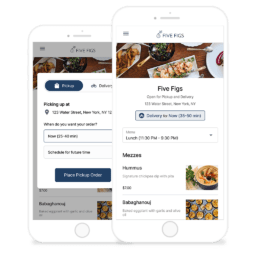The Ultimate Guide to Evaluating Restaurant Management Software
Molly Weinberg
5 min read
Sep 17, 2021

Molly Weinberg
5 min read
Sep 17, 2021

The hospitality industry is becoming increasingly tech-enabled, and restaurant management software is at the center of this tech revolution. From guest experience platforms to POS systems, software is making it possible for restaurateurs to streamline operations, access real-time data about their businesses, and give customers exactly what they’re looking for.
The number of restaurant management software options on the market has ballooned over the last few years, making it increasingly difficult to narrow down the options. We’ve created this restaurant management software guide to help you shop wisely and distinguish between features that will make an impact on your business, and ones that won’t. Whether you’re looking for a new guest engagement platform or POS system, this guide will help you find what you need.
Keep reading to learn:
Restaurant management software is any type of digital platform that makes running your restaurant easier. It can be a tool that focuses on one specific aspect of your business, such as managing reservations, or covers a wide spectrum of operations.
SevenRooms, for example, is an all-in-one Guest Experience and Retention platform that helps you acquire, engage, and retain customers through online ordering, reservations and waitlist management, CRM, and marketing automation features.
With so many types of restaurant management systems on the market, it can be difficult to discern which ones would be best for your business. Here’s what you should look for when asking yourself the question “How do I evaluate restaurant management software?”:
First things first: does the software do what you need it to do currently, and does it have features that will help your restaurant grow?
For example, if you currently run a ghost kitchen, you need a POS system and guest engagement tool that will let you take online orders and payments, collect and store customer information, incentivize repeat business, and access valuable analytics.
You may eventually want to expand to a brick and mortar restaurant, so you’ll need a tool that’s also equipped with features that will help you do that (such as managing reservations), so that you don’t have to waste time looking for a new restaurant management system when it’s time to expand.
Here’s a list of features you may want to look for, split up by function:
Look for software that gives you access to and ownership over the information it collects about your customers. Your restaurant management system should let you use this data to inform your business and marketing strategy, and inform the guest experience. That means the tool should integrate with and inform other tools in your tech stack, like your POS system and reservation software, and you should be able to export data.
Choose a restaurant management system that lets your business’s brand shine. It should be white-labeled so that your restaurant can put its logo front and center on customer-facing interfaces like online ordering and reservations pages.
Choose a restaurant management system that lets your business’s brand shine. It should be white-labeled so that your restaurant can put its logo front and center on customer-facing interfaces like online ordering and reservations pages.
SevenRooms provides white-labeled options to reflect your branding across online ordering and reservations. Check out how SevenRooms clients Fleming’s Steakhouse and Michael Mina in Las Vegas reflect their branding.

It’s important for restaurant management software to automate repetitive, manual tasks, especially during a labor shortage. Look for tools that make it possible to do more in less time, and with fewer people on your team.
For example, instead of having your host call guests to confirm reservations, your reservations software should automatically send reservation reminders via SMS. Instead of a team member reading comment cards, your marketing software should automatically collect feedback from guests, respond and provide analytics on guest sentiment.
And, instead of your front-of-house team manually entering diner preferences into your CRM, your restaurant management software should automatically tag guest profiles with their preferences.
Prioritize software that streamlines running your business. For more benefits of automation, check out a recent webinar with restaurant group, Mina Group.

Webinar
Learn More
Make sure any new restaurant management software you start using connects to and works well with your existing tech stack. While ideally you would only need one platform to run your entire business, there are cases in which you’d find it preferable to build your own system a la carte. For example, you may get your POS functionality from one vendor, your reservations and guest management capabilities from another and your inventory management solution from a third.
No matter which tools you use, make sure that they work together. If your tools integrate with each other, you won’t have to manually transfer data and the whole will be greater than the sum of its parts. For example, your table management software and POS should share data to help you track live spend and past purchases. This way you’ll know who your high spenders are so you can bring out complimentary champagne to thank them for their loyalty and make them feel like VIPs. .
Look for software that plays nicely with other platforms, shares data and increases the other’s functionality.
Restaurant management software should pay for itself in the value it brings your business. It should, for example, help you make more sales by running marketing promotions at the right time, reduce your labor costs by automating repetitive tasks or save you money by helping you avoid third-party commission fees.
So, when examining pricing, don’t just look for software that fits your budget, but software that will add value to your business.
Be wary of pricing that fluctuates based on use. Some software charges a low base fee, but then tacks on commission or cover fees that essentially penalize your business for attracting customers, and makes knowing what you’ll owe each month impossible to predict.
Instead, look for a restaurant management system that offers transparent, flat monthly or annual pricing, so you know what you’re paying each time you get a bill and you’re not penalized for taking more reservations or getting more online orders.
Restaurant software is made to be accessed while you’re on site. However, it’s much more powerful when you can also access your restaurant’s data off premises and in real-time.
Look for cloud-based software (as opposed to local, network-based software) that lets you login to the platform from any device. With remote, cloud-based access to your data, you can see customer information, manage inventory and update marketing campaigns whether you’re at your restaurant, at home or on vacation.
Any platform that also has a mobile app gets bonus points for convenience.
Support
Many restaurant technology platforms boast about their powerful capabilities but offer little in terms of support when you have trouble configuring the system or troubleshooting. Look for software that comes with comprehensive, accessible support.
Beyond just having access to documentation, you should be able to reach support in a number of ways, like via email, chat or phone. Not only that, but the support team should be available when it’s convenient for you.
They should also provide help with onboarding, training and platform customization. After all, it’s in their best interest to keep you as a customer. If you have trouble using their restaurant management software, then you likely won’t extend your license.
It’s important to know what you’re looking for when shopping around for restaurant management software. Begin your search by discovering your needs, then evaluating your options.
Use this software evaluation checklist to help you keep your needs top of mind while you shop around. Make a copy for each platform you’re considering.
Features
Data
Branding
Automation
Integrations
Pricing
Remote access
Support
If you’re looking for a guest engagement and retention platform that ticks all of the boxes above, look no further than SevenRooms. Book a demo today.